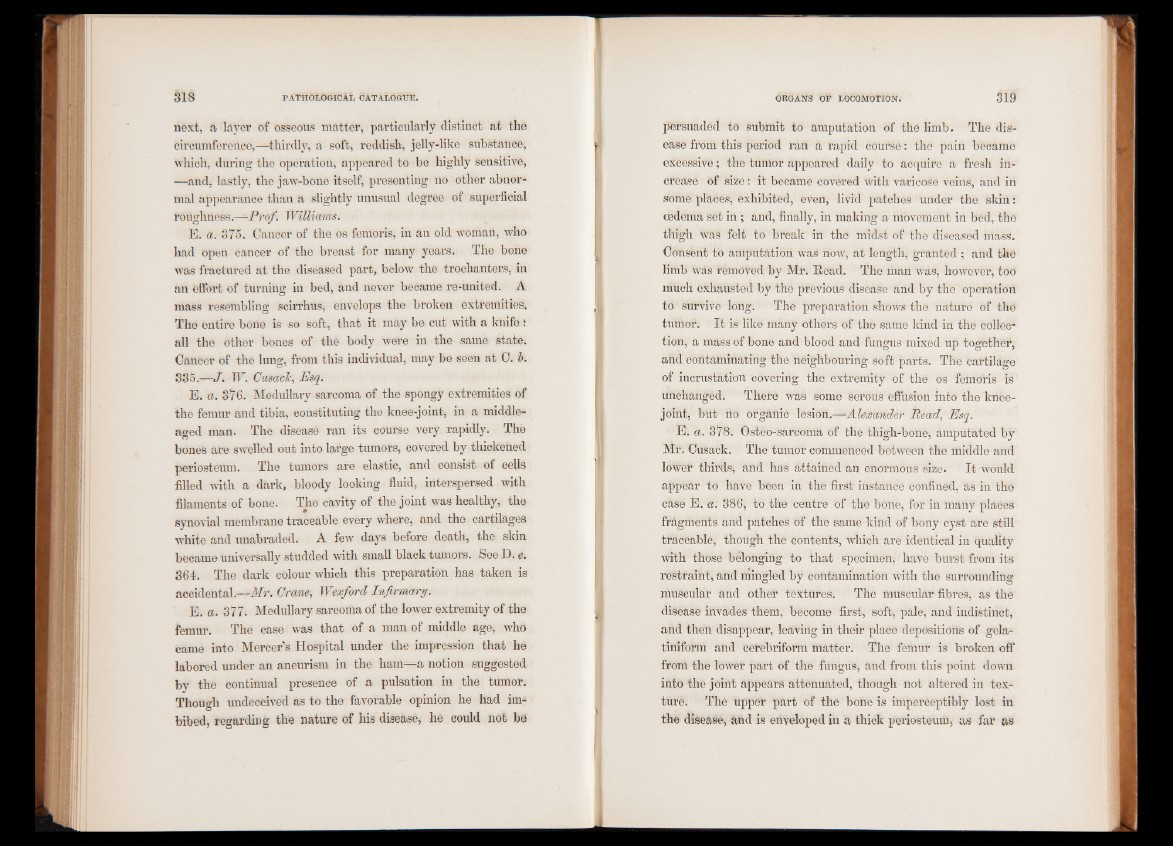
next, a layer of osseous matter, particularly distinct at the
circumference,—thirdly, a soft, reddish, jelly-like substance,
which, during the operation, appeared to be highly sensitive,
—and, lastly, the jaw-bone itself, presenting no other abnormal
appearance than a slightly unusual degree of superficial
roughness.—Prof. Williams.
E. a. 375. Cancer of the os femoris, in an old woman, who
had open cancer of the breast for many years. The bone
was fractured at the diseased part, below the trochanters, in
an effort of turning in bed, and never became re-united. A
mass resembling scirrhus* envelops the broken extremities;
The entire bone is so soft, that it may be cut with a knife !
all the other bones of the body were in the same state.
Cancer of the lung, from this individual, may be seen at 0. 5.
335.—J. W. Cusack, Esq.
E. a. 376. Medullary sarcoma of the spongy extremities of
the femur and tibia, constituting the knee-joint, in a middle-
aged man. The disease ran its course very rapidly. The
bones are swelled out into large tumors, covered by thickened
periosteum. The tumors are elastic, and consist of cells
filled with a dark, bloody looking fluid, interspersed with
filaments of bone. The cavity of the joint was healthy, the
synovial membrane traceable every where, and the cartilages
white and unabraded. A few days before death, the skin
became universally studded with small black tumors. See D. e.
364. The dark colour which this preparation has taken is
accidental.—Mr. Crane, Wexford Infirmary.
E. a. 377. Medullary sarcoma of the lower extremity of the
femur. The case was that of a man of middle age, who
came into Mercer’s Hospital under the impression that he
labored under an aneurism in the ham—a notion suggested
by the continual presence of a pulsation in the tumor.
Though undeceived as to the favorable opinion he had imbibed,
regarding the nature of his disease, he could not be
persuaded to submit to amputation of the limb. The disease
from this period ran a rapid course: the pain became
excessive; the tumor appeared daily to acquire a fresh increase
of size: it became covered with varicose veins, and in
some places, exhibited, even, livid patches under the skin:
oedema set in ; and, finally, in making a movement in bed, the
thigh was felt to break in the midst of the diseased mass.
Consent to amputation was now, at length, granted ; and the
lifcnb was removed by Mr. Read. The man was, however, too
much exhausted by the previous disease and by the operation
to survive long. The preparation shows the nature of the
tumor. It is like many others of the same kind in the collection,
a mass of bone and blood and fungus mixed up together,
and contaminating the neighbouring soft parts. The cartilage
of incrustation covering the extremity of the os femoris is
unchanged. There was some serous'effusion into the knee-
joint, but no organic lesion.—■ Alexander Read, Esq.
E. a. 378. Osteo-sarcoma of the thigh-bone, amputated by
Mr. Cusack. The tumor commenced between the middle and
lower thirds* and has attained an enormous size. It would
appear to have been in the first instance confined, as in the
case E. a. 386, to the centre of the bone, for in many places
fragments and patches of the same kind of bony cyst are still
traceable, though the contents, which are identical in quality
with those belonging to that specimen, have burst from its
restraint, and mingled by contamination with the surrounding
muscular and other textures. The muscular fibres, as the
disease invades them, become first, soft, pale, and indistinct,
and then disappear, leaving in their place depositions of gela-
tiniform and cerebriform matter. The femur is broken off
from the lower part of the fungus, and from this point down
into the joint appears attenuated, though not altered in texture.
The upper part of the bone is imperceptibly lost in
the disease, and is enveloped in a thick periosteum, as far as